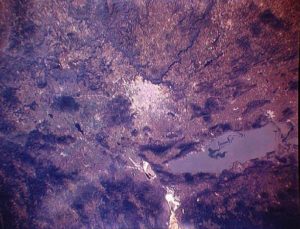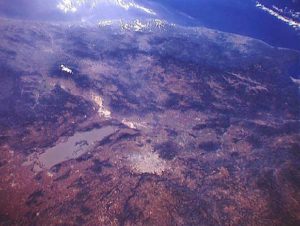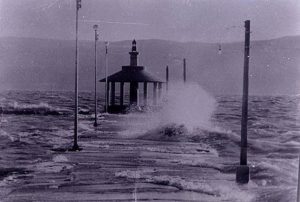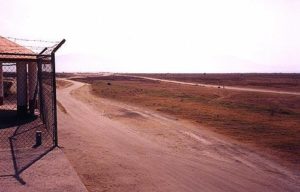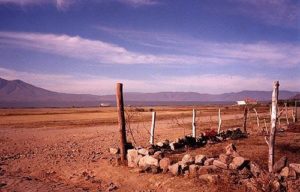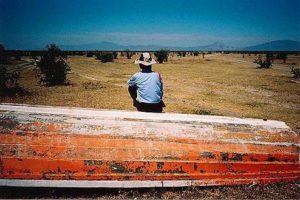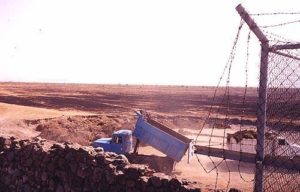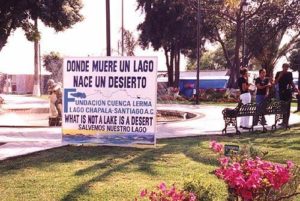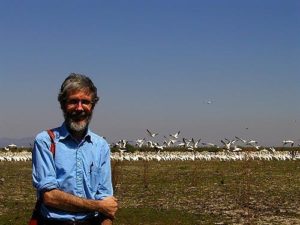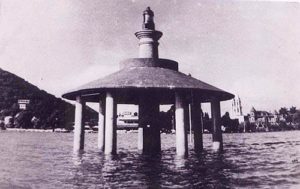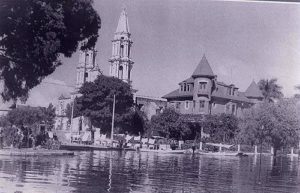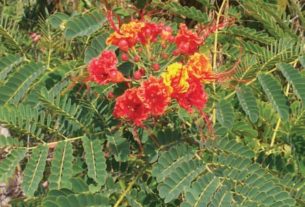This article is Part 2 of Tony Burton’s series:
“Can Mexico’s Largest Lake be Saved?” .
Part 1: May, 1997 – Can Mexico’s Largest Lake be Saved?
Part 3: March, 2001 – The Future of Lake Chapala–Suggestions For Discussion
Part 4: May 2002 – Lake Chapala–Fish Farm, Farmland or Bungee Jump?
Part 5: April 2003 – A review of “The Lerma-Lake Chapala watershed: evaluation and management”
Even though I have received very little feedback concerning my previous article about Lake Chapala´s precarious situation (Part 1), originally published in Ecodecision in 1997, and Mexico Connect in 1998, I feel the time is appropriate to present a brief survey of some of the more significant changes affecting the lake since that time.
Lake Levels:
The level of water in the lake has remained well below the average for the twentieth century. Since 1997, the ¨cota¨ has not exceeded 94.5 for even a single day. Taking the century as a whole, the cota (an arbitrary standard of measurement for Lake Chapala lake levels) only fell below 94.5 in the period from 1948-57, a period of unusually low rainfall throughout the Lerma-Chapala basin, and in every year since 1983. Since 1983, however, rainfall levels have been significantly higher than during the 1950s drought. During the past two years, getting to the tourist launches in Chapala requires either a long walk or a taxi ride across the wide expanse of exposed lake bed now surrounding Chapala pier.
The retreating shoreline has had far greater effects along some stretches of the southern shore of the lake. For example, the exposed area of the delta of the Passion river near Tizapan El Alto is now many times larger than it was eight years ago. The size and shape of Lake Chapala, as recorded on the 1:50,000 topographic sheet (last revised in the 1960s) now bears very little resemblance to reality. Not only is the lake significantly shorter (east-west) but the entire “Bay of Cojumatlan”, a nineteenth century lair for pirate ships in its south-east corner, is now filled in and has been converted to farmland.
At numerous points around the lake, the newly exposed lakebed has already been “colonised”, with temporary federal government permits, by land-starved farmers. More significantly, since 1980, many new public buildings or nurseries have been constructed on the lakebed, in locations which were completely under water until the 1950s and then again under water from 1960 to 1980. These changes in the use of the lakebed obviously must complicate any future programs designed to increase lake levels.
Pollution
Aquatic weeds. The water hyacinth is no longer covering a disproportionate part of the lake and its coverage is back to its “normal” level of 5% or less. While, in part, this may be due to continuing efforts by the State government to pull masses of the weed from the lake, it is also likely that, for currently undetermined reasons, the hyacinth entered the “regressive phase” of its own natural cycle of growth and decay.
Chemical pollution.
There has been no change in the situation as regards chemical pollutants, either in the Lerma basin or in Lake Chapala and there is no reason to suppose that there has been any significant decrease in the disturbing levels of heavy metals and other contaminants reported in my original article.
Development of the North Shore
The north shore, particularly the area around Ajijic and San Juan Cosalá has enjoyed “boom years” since 1997, with rising housing prices and a marked increase in economic activity and construction, much of which has been on the lower slopes of the Sierra Travesaño. The main lakeshore highway has been widened and improved from Chapala as far as Jocotepec. The number of buildings currently under construction is probably higher than it has ever been and some residents are convinced that the area is now being over-built.
None of the new developments appear to have any concern about their water supplies, even though the demands on available water must be increasing rapidly. To the best of my knowledge, none of the local realtors or developers has made any attempt to encourage the use of water saving devices in homes or in gardens. A very large proportion of homes in Ajijic continue to boast green lawns and full swimming pools all year, even though their maintenance requires large quantities of water. However, water conservation issues have apparently become a priority in Chapala where the town council (whose jurisdiction includes Ajijic) has stated its intention to introduce municipal regulations governing water use.
While probably not directly connected to the development of new settlement, a severe localized storm which hit the hillside above San Juan Cosala in the fall of 1998 was responsible for a major mudslide which washed out several houses, blocked the shoreline highway and changed the shoreline of the lake near the waste-water treatment plant at the western end of the village.
But there are some positive signs, too.
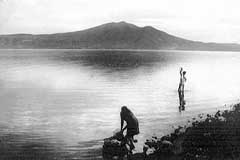 Local groups like “Friends of the Lake” (” Amigos del Lago“) have become better supported and have been very active in promoting greater awareness about the lake. High-profile fund-raisers appear to have been well received by the community at large. Two of the local newspapers (the English-language Guadalajara Reporter and the Spanish-language El Charal) have devoted numerous columns to the lake and its problems during the past three years. On July 3 this year, people concerned about the lake´s situation are being asked to come out in force and attempt to join hands to make a human chain encircling the lake. While it is unlikely the attempt can succeed – it would require about 300,000 participants to encircle the lake – it will undoubtedly result in considerable favorable publicity and further demands for the lake to be restored. Hopefully, all the local groups can present a united front in future discussions about the lake and its basin, ensuring, by the size of their pressure-group, that their suggestions and proposals have to be taken into serious consideration by the authorities responsible for developing an action plan.
Local groups like “Friends of the Lake” (” Amigos del Lago“) have become better supported and have been very active in promoting greater awareness about the lake. High-profile fund-raisers appear to have been well received by the community at large. Two of the local newspapers (the English-language Guadalajara Reporter and the Spanish-language El Charal) have devoted numerous columns to the lake and its problems during the past three years. On July 3 this year, people concerned about the lake´s situation are being asked to come out in force and attempt to join hands to make a human chain encircling the lake. While it is unlikely the attempt can succeed – it would require about 300,000 participants to encircle the lake – it will undoubtedly result in considerable favorable publicity and further demands for the lake to be restored. Hopefully, all the local groups can present a united front in future discussions about the lake and its basin, ensuring, by the size of their pressure-group, that their suggestions and proposals have to be taken into serious consideration by the authorities responsible for developing an action plan.
All levels of government are supporting the initiative to have Lake Chapala declared a “Cultural Patrimony of Mankind” by UNESCO. An initial application is now being prepared, though it may take several years before any decision is forthcoming. Such a status would raise the stakes as far as the lake´s danger of demise is concerned, but would have no immediate effect on funding or international assistance.
The federal government minister for the environment has visited the Lake and has restated the government´s financial and moral commitment to restoring Lake Chapala to health. The state government has also pledged large sums of money to be spent on additional waste-water treatment plants, as well as on reforesting parts of the lake basin and on various other projects.
Among the proposals originally pushed by state authorities was that of deliberately draining the eastern half of the lake, by constructing a north-south dyke. This, so one engineer maintained, would ensure the survival of the lake by decreasing its surface area and reducing evaporation losses. Shades of 1906-8!! Fortunately, this simplistic suggestion has met with well-justified skepticism and, judging by newspaper reports, resistance on the part of local residents. The engineer in question has since resigned, so hopefully this proposal has now, finally, been laid to rest.
Sadly, the project focused on public health outlined in my original article about the lake did not come to fruition and has been abandoned. In its place, CEATEJ researchers like Jose de Anda, who has been fostering close ties with fresh-water restoration programmes in Germany and Canada, have been instrumental in helping organize several important academic events. In March (this month), scientists from Environment Canada, along with de Anda and other Mexican researchers are holding a three-day course in lake restoration aimed at local administrators, scientists and the general public. The course is being held on the campus of ITESO in Guadalajara. ITESO continues to have an active cross-disciplinary “Chapala workshop” program, which has made numerous sound proposals for sustainable development projects since its inception about five years ago.
CEATEJ is also supporting a major international congress about Lake Chapala, to be held in the Hotel Real de Chapala in Ajijic in mid-April. After a complete dearth of articles about Lake Chapala in the international academic press in recent years, de Anda (and others) have managed to get some exposure in academic journals abroad, with numerous other articles currently awaiting acceptance by editorial boards. The April congress will enable researchers in diverse fields to learn about the results of on-going work being carried out by their peers in other disciplines. When published, the proceedings of the April congress, to be made available in both English and Spanish, should help to provide a sound scientific basis for uniting the international scientific community behind proposals for restoration and sustainable development.
After the April congress, I will endeavor to produce a further update on the Lake Chapala situation for MexConnect readers . . .
Part 3: Update November 2000
Images of Lake Chapala

